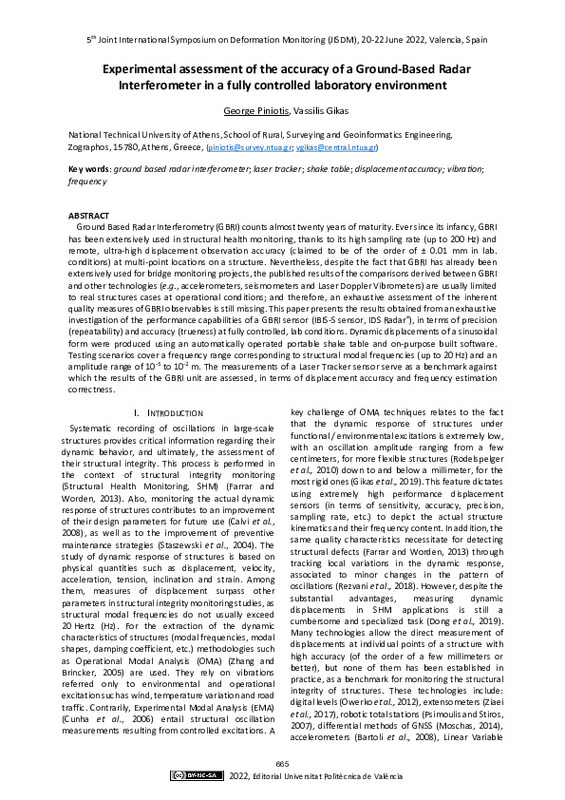JavaScript is disabled for your browser. Some features of this site may not work without it.
Buscar en RiuNet
Listar
Mi cuenta
Estadísticas
Ayuda RiuNet
Admin. UPV
Experimental assessment of the accuracy of a Ground-Based Radar Interferometer in a fully controlled laboratory environment
Mostrar el registro sencillo del ítem
Ficheros en el ítem
| dc.contributor.author | Piniotis, George
|
es_ES |
| dc.contributor.author | Gikas, Vassilis
|
es_ES |
| dc.date.accessioned | 2023-03-06T12:02:08Z | |
| dc.date.available | 2023-03-06T12:02:08Z | |
| dc.date.issued | 2023-01-27 | |
| dc.identifier.isbn | 9788490489796 | |
| dc.identifier.uri | http://hdl.handle.net/10251/192342 | |
| dc.description.abstract | [EN] Ground Based Radar Interferometry (GBRI) counts almost twenty years of maturity. Ever since its infancy, GBRI has been extensively used in structural health monitoring, thanks to its high sampling rate (up to 200 Hz) and remote, ultra-high displacement observation accuracy (claimed to be of the order of ± 0.01 mm in lab. conditions) at multi-point locations on a structure. Nevertheless, despite the fact that GBRI has already been extensively used for bridge monitoring projects, the published results of the comparisons derived between GBRI and other technologies (e.g., accelerometers, seismometers and Laser Doppler Vibrometers) are usually limited to real structures cases at operational conditions; and therefore, an exhaustive assessment of the inherent quality measures of GBRI observables is still missing. This paper presents the results obtained from an exhaustive investigation of the performance capabilities of a GBRI sensor (IBIS-S sensor, IDS Radar®), in terms of precision (repeatability) and accuracy (trueness) at fully controlled, lab conditions. Dynamic displacements of a sinusoidal form were produced using an automatically operated portable shake table and on-purpose built software. Testing scenarios cover a frequency range corresponding to structural modal frequencies (up to 20 Hz) and an amplitude range of 10-5 to 10-2 m. The measurements of a Laser Tracker sensor serve as a benchmark against which the results of the GBRI unit are assessed, in terms of displacement accuracy and frequency estimation correctness. | es_ES |
| dc.format.extent | 8 | es_ES |
| dc.language | Inglés | es_ES |
| dc.publisher | Editorial Universitat Politècnica de València | es_ES |
| dc.relation.ispartof | 5th Joint International Symposium on Deformation Monitoring (JISDM 2022) | |
| dc.rights | Reconocimiento - No comercial - Compartir igual (by-nc-sa) | es_ES |
| dc.subject | Ground based radar interferometer | es_ES |
| dc.subject | Laser tracker | es_ES |
| dc.subject | Shake table | es_ES |
| dc.subject | Displacement accuracy | es_ES |
| dc.subject | Vibration | es_ES |
| dc.subject | Frequency | es_ES |
| dc.title | Experimental assessment of the accuracy of a Ground-Based Radar Interferometer in a fully controlled laboratory environment | es_ES |
| dc.type | Capítulo de libro | es_ES |
| dc.type | Comunicación en congreso | es_ES |
| dc.rights.accessRights | Abierto | es_ES |
| dc.description.bibliographicCitation | Piniotis, G.; Gikas, V. (2023). Experimental assessment of the accuracy of a Ground-Based Radar Interferometer in a fully controlled laboratory environment. En 5th Joint International Symposium on Deformation Monitoring (JISDM 2022). Editorial Universitat Politècnica de València. 665-671. http://hdl.handle.net/10251/192342 | es_ES |
| dc.description.accrualMethod | OCS | es_ES |
| dc.relation.conferencename | 5th Joint International Symposium on Deformation Monitoring | es_ES |
| dc.relation.conferencedate | Junio 20-22, 2022 | es_ES |
| dc.relation.conferenceplace | València, España | es_ES |
| dc.relation.publisherversion | http://ocs.editorial.upv.es/index.php/JISDM/JISDM2022/paper/view/13930 | es_ES |
| dc.description.upvformatpinicio | 665 | es_ES |
| dc.description.upvformatpfin | 671 | es_ES |
| dc.type.version | info:eu-repo/semantics/publishedVersion | es_ES |
| dc.relation.pasarela | OCS\13930 | es_ES |






